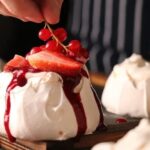Are you looking to add a touch of elegance and natural beauty to your cakes? In this article, we will show you how to make edible flowers for cake decorating.
Whether you’re a professional baker or just love to bake at home, edible flowers can take your cake decorating skills to the next level. From selecting the right flowers to preserving them on your cakes, we’ll guide you through the process of creating stunning floral decorations that are not only beautiful but also safe to eat.
When it comes to adding a unique and eye-catching element to your cakes, edible flowers are the perfect choice. Not only do they add a pop of color and a touch of nature, but they can also be tailored to fit any theme or style. With our step-by-step guide, you’ll learn how to carefully select the best edible flowers for cake decorating and prepare them for use on your baked creations.
In this article, we’ll cover everything from choosing the right edible flowers for cake decorating to creating beautiful floral decorations that will impress all your friends and family. We’ll also offer tips on how to preserve these delicate decorations on your cakes so that they stay looking fresh and beautiful for as long as possible. So if you’re ready to elevate your cake decorating game with stunning edible flower designs, keep reading.
Selection of Edible Flowers for Cake Decorating
Edible flowers add a beautiful and unique touch to cake decorating. When selecting edible flowers for cake decorating, it is crucial to ensure that the flowers are both safe to eat and free from pesticides. Common flowers used for cake decorating include roses, violets, pansies, and lavender, among others. It’s important to note that only flowers specifically labeled as edible should be used for decorating cakes.
When purchasing or harvesting edible flowers for cake decorating, it is essential to consider how they will complement the flavor of the cake. Some flowers have a more delicate flavor, while others may be more robust or even slightly bitter. Understanding the flavors of different edible flowers can help you choose the perfect ones for your cake creation.
It’s also important to be aware of any potential allergies when choosing edible flowers for cake decorating. Some individuals may have allergies to certain types of flowers, so always take this into consideration when preparing cakes for gatherings or events.
| Edible Flowers | Flavor Profile |
|---|---|
| Roses | Delicate and floral |
| Violets | Sweet and fragrant |
| Pansies | Mild with a hint of wintergreen flavor |
| Lavender | Fragrant with a slightly citrusy taste |
Preparing Edible Flowers for Cake Decorating
Edible flowers are a beautiful and unique way to decorate cakes, adding a touch of elegance and natural charm. Before using edible flowers for cake decorating, it’s important to properly prepare them to ensure they are safe for consumption and visually appealing on the cake. Here’s how to prepare edible flowers for cake decorating:
1. Cleaning the Edible Flowers: The first step in preparing edible flowers for cake decorating is to clean them thoroughly. Gently rinse the flowers under cold water to remove any dirt, insects, or pesticides. Use a small brush to gently remove any debris from the petals or stamens.
2. Removing Inedible Parts: Not all parts of an edible flower may be suitable for consumption. For instance, some flowers may have bitter or tough stems that should be removed before decorating a cake. Carefully trim off any green sepals, stems, or pistils from the flowers.
3. Drying the Edible Flowers: After cleaning and removing inedible parts, it’s important to let the edible flowers dry completely before using them for cake decorating. Place the flowers on a paper towel and allow them to air dry for several hours. Alternatively, you can use a salad spinner to gently remove excess water from the petals.
Once the edible flowers are properly prepared, they are ready to be used as stunning decorations for your cakes. Whether you choose to adorn your cakes with delicate pansies, vibrant roses, or fragrant lavender blooms, these carefully prepared edible flowers will elevate your cake decorating skills to new heights.
Creating Edible Flower Decorations
Choosing the Right Flowers
When it comes to creating edible flower decorations for cake decorating, it is crucial to select the right types of flowers. Not all flowers are safe to eat, so it is important to choose edible flowers that are free from pesticides and other harmful chemicals. Some popular options for edible flowers include roses, violets, pansies, and lavender. It’s best to grow your own edible flowers or purchase them from a reputable source to ensure their safety for consumption.
Preparing Edible Flowers
Before using edible flowers for cake decorating, it is essential to properly prepare them. Start by gently rinsing the flowers under cold water to remove any dirt or insects. Then, carefully pat them dry with a paper towel. If the flowers have stems or leaves, be sure to remove them as they can make the decorations wilt quicker on the cake.
Techniques for Creating Edible Flower Decorations
There are various ways to create beautiful edible flower decorations for cake decorating. One simple technique involves placing individual petals onto the frosted cake in a pattern or scattered design. Another method is pressing the individual petals into fondant or gum paste and allowing them to dry before placing them on the cake. Additionally, whole small blooms can be strategically placed on top of the cake as a stunning centerpiece.
Overall, creating edible flower decorations for cake decorating requires attention to detail and patience but results in stunning and unique cakes that will impress any crowd.
Using Edible Flowers as Cake Toppers
When it comes to cake decorating, using edible flowers as cake toppers can take your creations to the next level. Not only do edible flowers add a pop of color and natural beauty to your cakes, but they also provide a unique and elegant touch that will impress your family and friends. Whether you’re celebrating a birthday, wedding, or any special occasion, edible flower cake toppers are sure to make a statement.
To incorporate edible flowers as cake toppers, consider using the following options:
- Freshly picked edible flowers: Select fresh edible flowers that are in season and pesticide-free. Some popular choices include pansies, roses, violets, lavender, and chamomile.
- Candied edible flowers: If you want to add a touch of sweetness to your cake decorations, consider candying edible flowers. This process involves coating the flowers in egg whites and sugar for a beautiful crystallized effect.
- Hand-piped buttercream flowers: If you prefer a more artistic approach, you can pipe buttercream or royal icing flowers directly onto your cakes.
No matter which option you choose, using edible flowers as cake toppers allows for endless creativity and customization. From whimsical garden arrangements to minimalistic elegance, the possibilities are truly endless when it comes to incorporating these natural beauties into your cake designs.
For those looking for inspiration on how to make edible flower decorations for their cakes,, I recommend experimenting with different types of edible flowers and techniques. Whether you opt for fresh blooms or delicately candied petals, adding edible flower cake toppers is a fantastic way to elevate the appearance of your baked creations while impressing guests with your artistic flair.
Tips for Preserving Edible Flowers on Cakes
When it comes to decorating cakes with edible flowers, it’s important to ensure that the flowers not only look beautiful but also remain fresh and safe to consume. Preserving edible flowers on cakes can be a bit tricky, but with the right techniques, you can keep them looking fresh and vibrant for an extended period of time. In this section, we will explore some helpful tips for preserving edible flowers on cakes.
One of the key factors in preserving edible flowers on cakes is ensuring that they are properly prepared before being placed on the cake. This involves carefully cleaning the flowers to remove any dirt or debris, as well as gently drying them to prevent wilting. Additionally, it’s essential to use only organic or pesticide-free edible flowers to avoid any potential health risks.
Another important tip for preserving edible flowers on cakes is to apply a thin layer of clear piping gel or egg white wash to the petals. This helps protect the flowers from moisture and oxidation, which can cause them to wilt and lose their vibrancy.
It’s important to note that while these methods can help preserve the appearance of the flowers, they may still wilt over time, so it’s best to add them to the cake just before serving.
In addition to using piping gel or egg white wash, you can also preserve edible flowers by gently pressing them between layers of paper towels and placing them in an airtight container in the refrigerator until you’re ready to decorate your cake. This method can help maintain the freshness and color of the flowers until they are ready to be used.
By following these tips for preserving edible flowers on cakes, you can ensure that your floral cake decorations look stunning and stay fresh for as long as possible.
| Tips | Instructions |
|---|---|
| Cleaning Edible Flowers | Remove any dirt or debris and gently dry them |
| Use Organic Flowers | Avoid potential health risks from pesticides |
| Apply Piping Gel or Egg White Wash | To protect from moisture and oxidation |
Edible Flower Cake Decorating Ideas
Edible flowers are a beautiful and unique way to decorate cakes, adding a touch of elegance and natural beauty to any dessert. In this section, we will explore some creative and inspiring ideas for using edible flowers to decorate cakes. Whether you’re a seasoned baker or new to cake decorating, these ideas will help you take your creations to the next level.
Decorating With Whole Flowers
One of the simplest ways to use edible flowers for cake decorating is to place whole flowers on top of the cake. Choose small, delicate flowers such as pansies, violas, or bachelor buttons for this purpose.
Gently wash and dry the flowers before placing them on the cake to remove any dirt or insects. You can arrange the flowers in a random pattern or create a more structured design by placing them around the edges or in a circular pattern on top of the cake.
Pressed Flower Designs
Pressed flowers can be used to create intricate designs on cakes, adding a whimsical and artistic flair. To press flowers, place them between two sheets of absorbent paper and place heavy books on top for several days until they are completely dried and flat. Once pressed, these flowers can be carefully arranged on the surface of the cake in patterns or designs of your choosing. This method allows for endless creativity and customization in your cake decorating.
Candied Flowers
Candying edible flowers is another popular technique for cake decorating that not only enhances their appearance but also adds a sweet crunch to your cakes. To candy edible flowers, brush them with egg white using a small brush and then sprinkle them with superfine sugar. Let them dry at room temperature until they harden, creating beautiful and delicious decorations for your cakes. Candied violets, roses, or lavender buds are particularly stunning when used in this way.
These edible flower cake decorating ideas provide just a few examples of how you can elevate your cakes with natural beauty and flavor. Whether you choose whole flowers, pressed designs, or candied embellishments, incorporating edible flowers into your cake decorating repertoire is sure to impress and delight anyone who enjoys your creations.
Conclusion
In conclusion, adding edible flower decorations to your cakes can take your baking skills to the next level. By following the steps outlined in this article, you can create stunning and unique floral designs that will impress your friends and family. Whether you choose to use fresh or preserved edible flowers, the end result is sure to be a showstopper at any special occasion.
Now that you’ve learned how to make edible flowers for cake decorating, the possibilities are endless. You can experiment with different flower varieties, colors, and arrangements to customize your cakes for any theme or event. From elegant wedding cakes to whimsical birthday treats, edible flowers add a touch of natural beauty that is sure to delight everyone who sees and tastes your creations.
So go ahead and get creative with edible flower cake decorating. Whether you’re a beginner or a seasoned baker, incorporating edible flowers into your cake designs is a fun and rewarding way to elevate your dessert-making skills. With the knowledge and techniques from this article, you can confidently enjoy making beautiful and delicious edible flower-decorated cakes for all of life’s celebrations.
Frequently Asked Questions
How Do You Make Edible Flowers for Cakes?
To make edible flowers for cakes, you can use flowers that are safe for consumption, such as roses, violets, or pansies. It’s important to wash the flowers thoroughly and remove any stems or pistils before using them on the cake.
How Do You Make Flowers Safe for Cakes?
Making flowers safe for cakes involves ensuring that the flowers are free from pesticides or other harmful chemicals. It’s best to use organic or homegrown flowers for this purpose. Also, it’s important to confirm that the flowers are indeed edible and not toxic.
How to Make Icing Flowers for Beginners?
For beginners wanting to make icing flowers for cakes, there are various tutorials available online that provide step-by-step instructions on how to pipe different types of floral designs using frosting or royal icing. Practice and patience are key in mastering this skill.

Welcome to my blog about home and family. This blog is a place where I will share my thoughts, ideas, and experiences related to these important topics. I am a stay-at-home mom with two young children. I hope you enjoy reading it! and may find some helpful tips and ideas that will make your home and family life even better!





